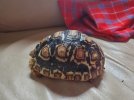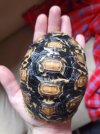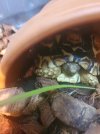My leopard tortoise is almost 1.5 years old. She was rather sickly when I received her and it took a solid six months of attention to get her healthy. During that extended bout of sickness, her growth was very sporadic.
I've noticed her shell has some strange growth despite my best efforts to control diet, lighting, and humidity. It's full of dents and weird buckling, with signs of pyramiding despite parameters being correct.
During summer she eats foraged weeds. In winter, a variety of lettuces, opuntia cactus, bok choy leaves, dandelion, collard greens, occasional mazuri, sunflower microgreens, kale. I try and supplement with Reptivite with D3 twice weekly but she hates it.
Lighting is T5 Arcadia 12% tube with a 100 watt halogen and CHEs. Humidity is realistically around 70%. I aim for 80%.
Any thoughts?
I've noticed her shell has some strange growth despite my best efforts to control diet, lighting, and humidity. It's full of dents and weird buckling, with signs of pyramiding despite parameters being correct.
During summer she eats foraged weeds. In winter, a variety of lettuces, opuntia cactus, bok choy leaves, dandelion, collard greens, occasional mazuri, sunflower microgreens, kale. I try and supplement with Reptivite with D3 twice weekly but she hates it.
Lighting is T5 Arcadia 12% tube with a 100 watt halogen and CHEs. Humidity is realistically around 70%. I aim for 80%.
Any thoughts?





